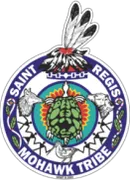By Darren Bonaparte, Director of the St. Regis Mohawk Tribe’s Tribal Historic Preservation Office
[Presented at the SRMT Monthly Meeting on August 10, 2019]
There are historical documents that state the names of the community in the early years of its existence. Since so few native people had learned to read and write in this era, we have only these non-native sources to go by. They mention both names for the community, Saint Regis and Akwesasne.
French sources from just before and immediately after the official founding of the St. Regis Mission (in 1754 and 1755) mention it as being located at “Lake Saint Francis” but do not give it a name. The conflict we know today as the Seven Years War was beginning, so naming a new mission might not have been high on their priority list.
A French military officer, Captain Louis Antoine de Bougainville, mentioned seeing “Fort St. Regis” during his travels on the St. Lawrence River on July 24, 1756:
“Left at half-past four, passed Anchorage Pont, Point a la Morandiere, Isle au Raisin, stopped to dine at Les Cheneaux, about three leagues from the entrance of the Lake. From there one could see Fort St. Regis, which is on Riviere a la Mme. This fort is stockaded, built last year. There is a Jesuit Mission there where some of the Iroquois have started to come.”1
Another French officer, Captain Pierre Pouchot, included St. Regis both in a map he drew and in his detailed notes that accompany it, compiled sometime around 1768:
“From Pointe a la Morandiere, navigation is constantly encumbered by rushes. Caution is necessary to keep the N. without getting too close to land in order to identify the correct channel of the river. After the rushes, the boat travels among a number of beautiful islands, which are called “Les Chaneaux”. After these islands, you cross to the S. shore if you want to visit the mission of St. Regis, recently established by the Jesuits though with very few missionaries. The lands in the surrounding area would be admirable for cultivation. It is very fine hunting country.”2
In the summer of 1760, a massive British army 10,000 strong descended the St. Lawrence on its way to conquer Montreal, the last outpost of New France. It was led by the commander-in-chief for the British army in North America, Jeffery Amherst. Sir William Johnson, Britain’s Superintendent of Indian Affairs, was among the officers, and he had with him agents from his Indian department and several hundred Haudenosaunee warriors.
Those who dealt with “Indian Affairs” for the British made it a habit of using the indigenous names for the communities they dealt with, even when they were known to have an English or French name.
Captain John Knox was another officer on this expedition. He mentioned a visit to “Hasquesashnagh” in his journal entry for the first few days of September:
“Sir William Johnson and his Myrmidons went to Hasquesashnagh, a small Indian village of the five nations, to smoke the pipe of peace, and to assure them of our protection, upon their future good behavior.”3
General Jeffery Amherst, who led this campaign, wrote the following letter to Sir William Johnson on September 3, 1760. He gives “Asquesashna” as another variation of the community’s name:
“I am Just now Informed, there is an English Prisoner at Asquesashna, A young Lad, if this is the Case I beg the favor of You to Send One of Your Officers to demand this Prisoner, or any Other of the Kings Subjects they may have, as I by no means Intend to leave any Subject of the British Crown, in the hands of any of the Enemy’s Indians; the Indians may be Assured of all the protections I can give them, and that I will not permit any one to molest them; but the Kings Subjects Wherever I find them either in French or Indian hands, I design to release.”4
The Mohawk Valley town of Fonda is named after Jelles Fonda, who lived where the Mohawk community of Kanatsiohareke is now located. He is the ancestor of well-known actors Henry, Jane, Peter, and Bridget Fonda. Jelles worked for Sir William Johnson’s Indian Department and was a part of the conquest of New France. His journal for September of 1760, also included in the Johnson papers, mentions “ochquasasne” three times:
“—Sunday the 29 Set of in ye. morning and this night laid nere ochquesasne on an Eyland.
the 30 Reaned and Stayed at ochquesasne
the 1 of october Set of from ochquesasne & layed at Tarunque”5
The Johnson papers include a “List of the Names of Indians who Accompanied the General to Montreal, and to whom Silver Medals have been delivered.” This 1761 document includes six unnamed recipients from “Aughquisasne.”6
The same volume of The Papers of Sir William Johnson includes a letter from Major-General Henry Gladwin to Jeffery Amherst date April 4th, 1762, in which the same name is given as “Aquasasnagh.” This is the extract in which it is mentioned:
“Yesterday a Coghanawaga Indian came here, he has often been of use to the Garrison, in which he always found his account, for this reason I thought him a proper hand to question about the practices of our Enemies below, he immediately replied he would tell me all he knew, in Substance as follows. That immediately after the reduction of Canada, the Priest of Aquasasnagh made four very large belts, after the Chiefs of that Village had declared they would have no hand in it; that two of these belts were sent to the Northern Indians by St. Luke LeCorn, the other two came this way, and the meaning of them was, that a French fleet, and Army would come over the ensueing spring to retake Canada, that now was their time, to rise and recover their Country; he likewise says, last fall the priest of Aquasasnagh, made the like number of belts as the year before, which were delivered in the same manner, with this difference only, that the Spaniards would joyn the French, and that they were invited to assemble at Frontenac; these belts were sent off just before St. Luke LeCorn took his departure for France; he has likewise given me the names of all the principal promoters of this affair, who are (he says) all equally concerned…”7
Elsewhere in this document, Gladwin mentions the “Priest at Sainte Registe,” no doubt a reference to Saint Regis. He then went to write another letter the following day in which he added further information about the priest at “Aquasasnagh,” adding that it was an “Abenaquis Woman” who made the dubious wampum belts “under his Eye.”8
Volume XI of The Papers of Sir William Johnson contains yet another variation of the name in “Complaint of Indians” dated September 8, 1764:
“Sir William Johnson received the following Complaint of the Indians [of] Aughquisasne, transmitted to him by Danl. Claus, Esqr. Depy. Agent for Canada, bearing date the 8th. Septemr. 1764—
That three Chiefs of Aughquisasne, or St. Regis, came to Col. Claus on this day, and complained that as one of the Chiefs was passing the Post at the Cedars with his family in a Birch Canoe, being on his way to Montreal upon some business with Capt. Claus, and going at a good rate before the wind, he heard a Shot fired, and not imagining it to be fired at him, he proceeded on his way, but immediately after another was fired within a few paces of him, but luckily the Ball struck a Wave in the Rift, which prevented it hitting the Canoe, and wounding or killing some one in it; after which he saw some Soldiers upon the Shore running with their Arms after the Canoe aiming at it, when, with difficulty he brought about, where the Water was very rapid, and put a Shore; that the Soldiers then Cursing, and Swearing, ordered him to push with his Canoe to the Officer’s House..”9
Daniel Claus used the spelling of “Aughquisasne” at other times in his correspondence, particularly on August 21, 1769, which we find in the seventh volume of The Papers of Sir William Johnson, and again on August 25, 1769. Both of these documents concerned the controversy that arose when Abenaki refugees from Odanak (St. Francis) began to wear out their welcome at Akwesasne. 10
From this initial survey of historical documents from 1760 to 1769, we have at least five different renderings of Akwesasne: Knox wrote it as Hasquesashnagh, Amherst Asquesashna, Fonda Ochquesasne, Claus Aughquisasne, and Gladwin Aquasasnagh. There may be other examples of the name in documents that have not yet been located.
The use of Akwesasne by outside officials began to fade away as years went by, so much so that it seemed a novelty when historian Franklin B. Hough made inquiries about origin of the name in the early 1850s.
CITATIONS
1 Louis Antoine de Bougainville, Adventures in the Wilderness: the American Journal of Louis Antoine de Bougainville, 1756-1760. Translated and edited by Edward P. Hamilton. University of Oklahoma Press, Norman, 1964 (1990 edition), p. 15.
2 Pierre Pouchot, Memoirs on the Late War in North America between France and England. Translated by Michael Cardy. Old Fort Niagara Association, Inc. Youngstown, 1994, p. 370.
3 Captain John Knox, An Historical Journal of the Campaigns in North America for the years 1757, 1758, 1759, and 1760. The Champlain Society, Toronto, 1914, Vol. II, p. 556.
4 Jeffery Amherst to Sir William Johnson, September 3, 1760. The Papers of Sir William Johnson, Volume X, p. 178.
5 Journal of Jelles Fonda, June 29-October 23, 1760. The Papers of Sir William Johnson, Volume XII, pp. 167-173.
6 A List of Indians, March-April, 1761. The Papers of Sir William Johnson, Volume X, pp. 251 to 254.
7 Henry Gladwin to Jeffery Amherst, April 4, 1762. The Papers of Sir William Johnson, Volume X, pp. 422-424.
8 Henry Gladwin to Jeffery Amherst, April 5, 1762. The Papers of Sir William Johnson, Volume X, pp. 424-425.
9 Complaint of Indians, September 8, 1764. The Papers of Sir William Johnson, Volume XI, pp. 351-352.
10 A Meeting with Aughquisasnes, August 21, 1769. The Papers of Sir William Johnson, Volume VII, pp. 109-112. From Daniel Claus, August 25, 1769. The Papers of Sir William Johnson, Volume VII, pp. 126-131.

